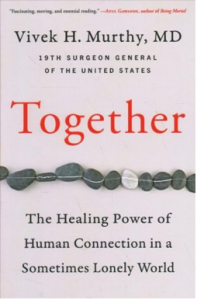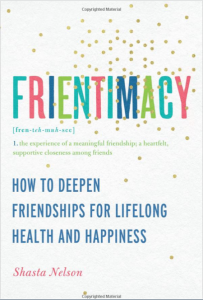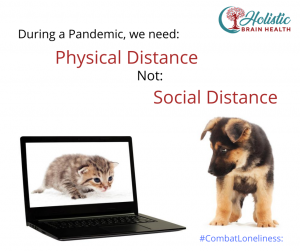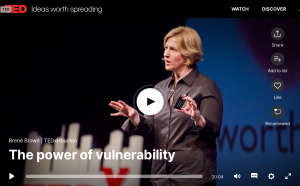How to Overcome Loneliness

Many of us have experienced loneliness at some point in our lives. Regardless of whether we are with people or not, it can manifest as this aching sense of not feeling heard or understood.
Loneliness increases our risk for depression, anxiety, and addictions as well as chronic diseases. It is a huge problem with the elderly, and people suffering from disabilities. And in the middle of a pandemic, the pervasive of loneliness is a huge social concern!
Levels of connection
 While we all have different needs with regards to the number of people we interact with, Dr. Vivek Murthy, MD., author of Together: the healing power of human connection in a sometimes lonely world says we need 3 levels of connection: intimate connection, good friends, and community.
While we all have different needs with regards to the number of people we interact with, Dr. Vivek Murthy, MD., author of Together: the healing power of human connection in a sometimes lonely world says we need 3 levels of connection: intimate connection, good friends, and community.
Those in our intimate connection group include family and significant others, but also close friends. The important thing is that with these intimate friends, we can be ourselves and share both our triumphs and tribulations. We may not need too many people in our inner circle, but it is important to try to have at least three or four so that we have the support when we need it the most. If one relationship becomes more challenging, it is important to have other support to help us reflect, and understand what we are going through.
Good friends might be people that you do activities with, but your connection may not be as deep. These friends could evolve to become more intimate friends at some point, if you both find a greater mutual connection.
A community helps to give us a shared identity. For example, we may join a religious organization, a sport’s team, a public speaking group, a non-profit working towards a cause we believe in, or a social group.
Depending on whether we fall more heavily onto the introvert versus extrovert spectrum, we may value the three levels of connection differently. For example, an introvert may enjoy spending most of their time with their more intimate connections, and less with their community. Where is an extrovert might thrive and enjoy large group experiences.
How to Make Friends
Shasta Nelson , author of Frientimacy: How to Deepen Friendships for Lifelong Health and Happiness, says that we aren’t properly schooled in how to be good friends, nor are we clear on what friendships are. She says it friendships need to be developed like muscles. We have to learn the skills for friendship, and then practice them.
, author of Frientimacy: How to Deepen Friendships for Lifelong Health and Happiness, says that we aren’t properly schooled in how to be good friends, nor are we clear on what friendships are. She says it friendships need to be developed like muscles. We have to learn the skills for friendship, and then practice them.
When choosing friends, we often think of the characteristics that they have (like humor or intelligence), rather than focusing on our mutual skills to be good friends. To have healthy relationships, we need to re-focus on how we make each other feel in the presence of each other.
Shasta Nelson says there are 3 main things we need to focus on to have healthy relationships.
-
Positivity
We have to have more positive than negative experiences with each other.
John Gottman, Ph.D., author of The Relationship Cure, says that we all make regular bids for connection. How do we respond to each other’s bids determines whether a relationship will thrive or die. Both Gottman and Nelson say that we need at least 5 positive experiences to every negative experience for a relationship to thrive.
-
Consistency
One of our challenges in our modern-day fast-paced world, is that the ways we meet each other are not conducive to facilitating long-term connections. For example, if we join a Meetup group, we may attend an event, and never see the same people again. But many of us need to develop familiarity with others before we can decide whether we would like to be friends. This requires connecting with the same people multiple times. Thus, finding groups that have memberships, or are working towards a common goal, help foster the sense of continuity that we need to develop friends.
 We can lose ties to our most important friends easily if we don’t make a concerted effort to see them regularly. The key to overcoming loneliness, is to not only have these friendships, but to nurture the friendships on a regular basis. For example, Dr. Murthy has two male friends who are a part of his inner circle. His friends are busy and productive like him, plus they live hundreds of miles apart. But they have pledged to meet by phone once a month to check in, where they share both celebrations and challenges with each other. He finds these intimate friendships to be deeply satisfying, and vital to his well-being.
We can lose ties to our most important friends easily if we don’t make a concerted effort to see them regularly. The key to overcoming loneliness, is to not only have these friendships, but to nurture the friendships on a regular basis. For example, Dr. Murthy has two male friends who are a part of his inner circle. His friends are busy and productive like him, plus they live hundreds of miles apart. But they have pledged to meet by phone once a month to check in, where they share both celebrations and challenges with each other. He finds these intimate friendships to be deeply satisfying, and vital to his well-being.
In seeking friends, some people get discouraged because they find that they are always the ones initiating connection. Shasta Nelson says that if you find that you were the one always initiating connection, it may be because your friend is busier, or may not be as social. But if your friend does spend time with you, and you continue to find the relationship to be gratifying, then do not be afraid to be the initiator in the relationship. Regardless be careful not to take this friend’s lack of initiation personally. Instead you could try to clarify each of your perspectives, and needs with friendships.
-
Vulnerability
As Brene Brown has so eloquently expressed, our ability to be
vulnerable allows us to deepen our connections.
But Shasta Nelson wisely advises that it is good to be wise and careful with our vulnerability. It isn’t necessarily a good idea to be vulnerable with people we barely know. It may not be safe. But as we get to know them, we can slowly determine over time whether they can be trustworthy with the information we give them. It takes time to develop a sense of how they might react to what we tell them, and to know if they will accept us as ourselves, and keep our secrets sacred.
Internal barriers to healthy relationships
In addition to knowing how to be a good friend, we also need to be emotionally open to healthy relationships. If we struggle with being positive, loving ourselves, or trusting others, it might be valuable to examine whether we are depressed, need to work on our relationship with our-self, or need to recover from unhealthy relationship experiences from our past. If you struggle with being in a good mental and emotional space for healthy relationships, then consider working with me to release the barriers getting in the way. The methods I use are relatively fast and thorough, and get straight to the underlying issues that need to be addressed.
Friendships while physical distancing
One of the challenges of the pandemic is that our regular habits of meeting with people have been disrupted. We can still have large group gatherings safely online, and most of us can find ways to meet with our most intimate circle of friends in safer ways. For example, we can meet our most intimate friends for outdoor activities that don’t encourage physical contact and where it is relatively easy to stay farther apart. Activities such as walking, hiking, biking or kayaking.
 We are fortunate that the pandemic hit when we have so many great ways of interacting online. The old term of social distancing is no longer relevant to our era. We should be encouraged to engage in physical distancing. Not social distancing! I get that many people do not enjoy interacting online. But if you are faced with the choices of being in danger of contracting or spreading the coronavirus, interacting online or by phone or being lonely, I suggest you choose the safest and wisest option.
We are fortunate that the pandemic hit when we have so many great ways of interacting online. The old term of social distancing is no longer relevant to our era. We should be encouraged to engage in physical distancing. Not social distancing! I get that many people do not enjoy interacting online. But if you are faced with the choices of being in danger of contracting or spreading the coronavirus, interacting online or by phone or being lonely, I suggest you choose the safest and wisest option.
The pandemic is a perfect opportunity to focus on deepening our relationships by learning about how to have healthy relationships, and exercising our friendship muscles. Having healthy relationships is vital for our mental and physical health. If this is something you struggle with, check out the books by Dr. Murthy and Shasta Nelson, and contact me to schedule a complimentary consultation.




